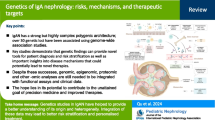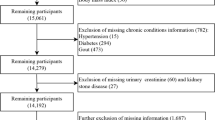Abstract
Idiopathic hypocitraturia (IH) is a risk factor for urolithiasis. IH is associated with vitamin D receptor (VDR) gene single nucleotide polymorphisms (SNPs) in a Chinese Han population. However, this association between VDR SNPs and IH has not been recapitulated in a Chinese Bai population. The aim of this study is to investigate the association between VDR SNPs and IH in a Chinese Bai population. A total of 320 participants comprising of 200 Chinese Bai patients with IH and 120 Chinese Bai control participants with normal urinary citrate level were enrolled for this study. The VDR SNPs rs7975232, rs2228570, rs731236 and rs1544410 were detected by Sanger sequencing, and the association between these SNPs and the presence of IH in the Chinese Bai population was analyzed. The prevalence of VDR SNPs rs7975232 allele A and rs2228570 genotype TT was significantly higher in patients than in controls (p < 0.0125, after Bonferroni correction). The haplotype TCGC was a protective factor in the Chinese Bai population who otherwise might suffer from IH, while the haplotype TTGA was a risk factor. VDR SNPs rs731236 and rs1544410 have a linkage disequilibrium value of 0.811. VDR SNPs rs7975232, rs2228570, and haplotypes TCGC, TTGA are associated with IH in a Chinese Bai population.


Similar content being viewed by others
References
Theka T, Rodgers AL, Webber D et al (2014) Variability in kidney stone incidence between black and white South Africans: AGT Pro11Leu polymorphism is not a factor. J Endourol 28(5):577–581
Turney BW, Appleby PN, Reynard JM et al (2014) Diet and risk of kidney stones in the Oxford cohort of the European Prospective Investigation into Cancer and Nutrition (EPIC). Eur J Epidemiol 29(5):363–369
Bae SR, Seong JM, Kim LY et al (2014) The epidemiology of reno-ureteral stone disease in Koreans: a nationwide population-based study. Urolithiasis 42(2):109–114
Jiang D, Geng H (2017) Primary hyperoxaluria. N Engl J Med 376(15):e33
Arrabal-Polo MA, Arias-Santiago S, Giron-Prieto MS et al (2012) Hypercalciuria, hyperoxaluria, and hypocitraturia screening from random urine samples in patients with calcium lithiasis. Urol Res 40(5):511–515
Rez P (2017) What does the crystallography of stones tell us about their formation? Urolithiasis 45(1):11–16
Rendina D, De Filippo G, Gianfrancesco F et al (2017) Evidence for epistatic interaction between VDR and SLC13A2 genes in the pathogenesis of hypocitraturia in recurrent calcium oxalate stone formers. J Nephrol 30(3):411–418
Haymann JP (2015) Metabolic disorders: stones as first clinical manifestation of significant diseases. World J Urol 33(2):187–192
Letendre J, Cloutier J, Villa L et al (2015) Metabolic evaluation of urinary lithiasis: what urologists should know and do. World J Urol 33(2):171–178
Kan WC, Chou YH, Chiu SJ et al (2014) Study of the association between ITPKC genetic polymorphisms and calcium nephrolithiasis. Biomed Res Int 2014:397826
Skolarikos A, Straub M, Knoll T et al (2015) Metabolic evaluation and recurrence prevention for urinary stone patients: EAU guidelines. Eur Urol 67(4):750–763
Arrabal-Martin M, Poyatos-Andujar A, Cano-Garcia Mdel C et al (2015) The importance of calciuria as lithogenic factors in patients with osteopenia/osteoporosis. Int Urol Nephrol 47(3):445–449
Rungroj N, Nettuwakul C, Sudtachat N et al (2014) A whole genome SNP genotyping by DNA microarray and candidate gene association study for kidney stone disease. BMC Med Genet 15:50
Vezzoli G, Terranegra A, Rainone F et al (2011) Calcium-sensing receptor and calcium kidney stones. J Transl Med 9:201
Bid HK, Chaudhary H, Mittal RD (2005) Association of vitamin-D and calcitonin receptor gene polymorphism in paediatric nephrolithiasis. Pediatr Nephrol 20(6):773–776
Basiri A, Shakhssalim N, Houshmand M et al (2012) Coding region analysis of vitamin D receptor gene and its association with active calcium stone disease. Urol Res 40(1):35–40
Ferreira LG, Pereira AC, Heilberg IP (2010) Vitamin D receptor and calcium-sensing receptor gene polymorphisms in hypercalciuric stone-forming patients. Nephron Clin Pract 114(2):c135–c144
Zuckerman JM, Assimos DG (2009) Hypocitraturia: pathophysiology and medical management. Rev Urol 11(3):134–144
Mossetti G, Vuotto P, Rendina D et al (2003) Association between vitamin D receptor gene polymorphisms and tubular citrate handling in calcium nephrolithiasis. J Intern Med 253(2):194–200
Zhu C, Ye Z, Chen Z et al (2010) Association between vitamin D receptor gene polymorphisms and idiopathic hypocitraturia in the Chinese population. Urol Int 85(1):100–105
Alatab S, Pourmand G, El Howairis Mel F et al (2016) National profiles of urinary calculi: a comparison between developing and developed worlds. Iran J Kidney Dis 10(2):51–61
Zeng G, Mai Z, Xia S et al (2017) Prevalence of kidney stones in China: an ultrasonography based cross-sectional study. BJU Int 120(1):109–116
Wu W, Yang D, Tiselius HG et al (2014) The characteristics of the stone and urine composition in Chinese stone formers: primary report of a single-center results. Urology 83(4):732–737
Lieske JC, Turner ST, Edeh SN et al (2014) Heritability of urinary traits that contribute to nephrolithiasis. Clin J Am Soc Nephrol 9(5):943–950
Ferraro PM, Robertson WG, Johri N et al (2015) A London experience 1995–2012: demographic, dietary and biochemical characteristics of a large adult cohort of patients with renal stone disease. QJM J Med 108(7):561–568
Rull MO, Ochoa-Hortal MA, Cano-Garcia MC, Martin MA et al (2015) Calcium and phosphorus metabolism and lithogenic factors in patients with osteoporotic fracture. Actas Urol Esp 39(5):279–282
Uitterlinden AG, Fang Y, van Meurs JBJ et al (2004) Genetics and biology of vitamin D receptor polymorphisms. Gene 338:143–156
Mostowska A, Lianeri M, Wudarski M et al (2013) Vitamin D receptor gene BsmI, FokI, ApaI and TaqI polymorphisms and the risk of systemic lupus erythematosus. Mol Biol Rep 40(2):803–810
Zhan Y, Liu M, You Y et al (2015) Genetic variations in the vitamin-D receptor (VDR) gene in preeclampsia patients in the Chinese Han population. Hypertens Res 38(7):513–517
Carvalho AY, Bishop KS, Han DY et al (2013) The role of Vitamin D level and related single nucleotide polymorphisms in Crohn’s disease. Nutrients 5(10):3898–3909
Ferrarezi DA, Bellili-Munoz N, Nicolau C et al (2012) Allelic variations in the vitamin D receptor gene, insulin secretion and parents’ heights are independently associated with height in obese children and adolescents. Metabolism 61(10):1413–1421
Al-Daghri NM, Al-Attas OS, Alkharfy KM et al (2014) Association of VDR-gene variants with factors related to the metabolic syndrome, type 2 diabetes and vitamin D deficiency. Gene 542(2):129–133
Mao S, Huang S (2014) Vitamin D receptor gene polymorphisms and the risk of rickets among Asians: a meta-analysis. Arch Dis Child 99(3):232–238
Bermúdez-Morales VH, Fierros G, Lopez RL et al (2017) Vitamin D receptor gene polymorphisms are associated with multiple sclerosis in Mexican adults. J Neuroimmunol 306:20–24
Shahbazi S, Alavi S, Majidzadeh AK et al (2013) BsmI but not FokI polymorphism of VDR gene is contributed in breast cancer. Med Oncol 30(1):393
Liu S, Cai H, Cheng W et al (2017) Association of VDR polymorphisms (Taq I and Bsm I) with prostate cancer: a new meta-analysis. J Int Med Res 45(1):3–10
Bai YH, Lu H, Hong D et al (2012) Vitamin D receptor gene polymorphisms and colorectal cancer risk: a systematic meta-analysis. World J Gastroenterol 18(4):1672–1679
Amaro CR, Goldberg J, Damasio PC et al (2015) An update on metabolic assessment in patients with urinary lithiasis. World J Urol 33(1):125–129
Domrongkitchaiporn S, Ongphiphadhanakul B, Stitchantrakul W et al (2000) Risk of calcium oxalate nephrolithiasis after calcium or combined calcium and calcitriol supplementation in postmenopausal women. Osteoporos Int 11(6):486–492
Pajor AM (2014) Sodium-coupled dicarboxylate and citrate transporters from the SLC13 family. Pflugers Arch 466(1):119–130
Ohana E, Shcheynikov N, Moe OW et al (2013) SLC26A6 and NaDC-1 transporters interact to regulate oxalate and citrate homeostasis. J Am Soc Nephrol 24(10):1617–1626
Hering-Smith KS, Schiro FR, Pajor AM et al (2011) Calcium sensitivity of dicarboxylate transport in cultured proximal tubule cells. Am J Physiol Renal Physiol 300(2):F425–F432
Medina-Escobedo M, Gonzalez-Herrera L, Villanueva-Jorge S et al (2014) Metabolic abnormalities and polymorphisms of the vitamin D receptor (VDR) and ZNF365 genes in children with urolithiasis. Urolithiasis 42(5):395–400
Funding
This study was funded by National Natural Science Foundation of China (Grant number 81460141), by Science and Technology Department of Yunnan Province Uniting Kunming Medical University Specialized Foundation (Grant number 2013FB134, 2017FE468(-029) and 2017FE467(-042)), by Doctoral Scientific Research Fund of the First Affiliated Hospital of Kunming Medical University (Grant number 2015BS026 and 2017BS016) and by the scientific research funding of Yunnan Provincial Department of Education (Grant number 2018JS208).
Author information
Authors and Affiliations
Contributions
KL and YL contributed equally to the paper.
Corresponding authors
Ethics declarations
Conflict of interest
The authors declare that they have no conflict of interest.
Ethical approval
All procedures performed in studies involving human participants were in accordance with the ethical standards of the institutional and/or national research committee and with the 1964 Helsinki Declaration and its later amendments or comparable ethical standards.
Informed consents
Informed consent forms were signed by all individual participants included in the study.
Electronic supplementary material
Below is the link to the electronic supplementary material.
Rights and permissions
About this article
Cite this article
Li, K., Luo, Y., Mo, Y. et al. Association between vitamin D receptor gene polymorphisms and idiopathic hypocitraturia in a Chinese Bai population. Urolithiasis 47, 235–242 (2019). https://doi.org/10.1007/s00240-018-1069-3
Received:
Accepted:
Published:
Issue Date:
DOI: https://doi.org/10.1007/s00240-018-1069-3




